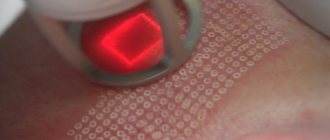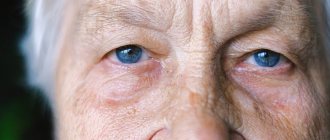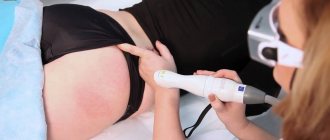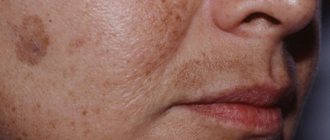Alexandrite
The laser wavelength is 755 nm, the impact frequency does not exceed 10 Hz, and the power is 16 J. Such low indicators allow the light beam to penetrate the epidermis to a depth of 3 mm. This explains its limited range of effects.
The device is used for hair removal, rejuvenation procedures, removal of shallow spider veins, and treatment of superficial dyschromia (for example, freckles).
The diameter of the light beam that acts on the skin is 18 mm. The session goes quickly, and the cooling system avoids burns. The specialist will adjust the radiation strength according to your skin type, which will eliminate the appearance of scars.
Recommendations before and after the procedure
- After the procedure, a small crust appears at the site of laser exposure. When it is naturally rejected, slight inflammation or weeping areas of the skin may occur. Under no circumstances should you remove any emerging formations on your own or try to speed up the natural regeneration processes in any way. If you ignore the doctor's recommendations, the wound may become infected and become inflamed, which can lead to the formation of a scar at the site of pigmentation.
- Before the procedure, it is important not to injure and protect the skin from various negative influences: avoid sunlight, do not use scrubs, peels and other traumatic cosmetics.
- In the first days after the procedure, it is important to follow the following recommendations:
- Keep the treated area of skin as intact as possible, avoid contact with water, dirt, and do not use cosmetics.
- Do not scratch the areas of skin treated with laser, do not remove the crust that appears on your own, do not use peelings and scrubs.
- Avoid ultraviolet (solarium and direct sunlight) and thermal (sauna) exposure.
- Do not use any healing products without a doctor's prescription.
- Follow the doctor’s instructions and use prescribed regenerating creams, ointments, vitamin complexes
- Do not forget about sunscreens with a high protection factor (the composition should contain zinc oxide).
KTP Q-Switch and ruby
Ruby lasers are a little slower than other types, so you need to go through more procedures to get the desired effect. They remove age spots and tattoos. The radiation affects follicles, but only a certain type, and is suitable for dark hair on fair skin.
The KTP Q-Switch laser from the German company Asclepion Laser Technologie is considered a more advanced model. It combines the properties of neodymium and ruby lasers. This innovative technology is based on a combination of high power and ultra-short pulses.
The fractional nozzle operates over an area of up to 10 mm. When changing it, the device automatically adjusts to the size of the spot, and the display shows all the information the cosmetologist needs. The equipment can be connected to a computer, and then all the data will be displayed on the screen.
The device removes multi-color tattoos, pigment spots, and spider veins well. It is used for rejuvenation, photoepilation, and treatment of acne. The laser is completely safe and minimizes the possibility of tissue scarring.
Pigment disorders are one of the most common types of dermatoses - in some populations, the percentage of people with such defects reaches 60%. This can be either hereditary or acquired darkening or lightening of skin areas, and even dyschromia of unusual color. Most pigment defects are associated with qualitative or quantitative disorders in the production or deposition of melanin, however, abnormal variations of other endogenous pigments are also found, and in some cases, even the deposition of exogenous pigments can lead to dyschromia (read our material about argyria). However, it is certainly defects associated with excess melanin deposition that make up the bulk of pigmentary disorders.
Today, lasers and intense pulsed light (IPL) sources are becoming increasingly popular in their correction. Sometimes they are considered almost a magical tool that can remove any type of damage. However, effective and safe removal of pigmentation is not possible with any device, and in order to choose them, you need to understand the peculiarities of the interaction of laser radiation with the skin and its chromophores. It is also necessary to take into account the main pathophysiological processes leading to this particular pigment disorder, as well as the types and location of pigments in the skin. Experts from the European Society of Laser Dermatology analyzed nearly 1,000 studies and articles published from 1983 to April 2022 and formulated a Position Statement regarding the correction of various types of dyschromia using lasers and IPL devices.
Types of lasers for correcting pigment defects
The principle of light therapy for pigment defects is based on the concept of selective photothermolysis. It lies in the fact that melanin, like other skin chromophores, is able to absorb certain wavelengths more intensely than the structures surrounding it. Ideally, "pigment" lasers should generate radiation that is absorbed only by melanin, with minimal absorption by hemoglobin or water. However, the absorption spectrum of melanin overlaps with the absorption spectrum of these chromophores. The range between 630 and 1100 nm is considered relatively selective for affecting melanin, where there is good penetration of radiation into the skin and preferential absorption of melanin compared to oxyhemoglobin.
The intensity of melanin's absorption of light energy decreases with increasing wavelength of radiation, but a longer wavelength allows it to penetrate deeper into the skin. At the same time, shorter waves (<600 nm) can damage pigment cells with relatively low energy, while longer waves (>600 nm) penetrate deeper, but require more energy to cause damage to melanosomes. Thus, it is not possible to achieve an isolated effect on melanin only by selecting the wavelength (optical selectivity).
Therefore, another task arises - it is necessary to deliver the maximum number of photons to the target chromophore before they are “captured” by competing chromophores that are located near the target. This is possible thanks to the optimal selection of pulse duration and radiation energy density.
Since melanin and the melanosomes containing it are very small, their destruction requires less prolonged heating than, for example, coagulation of blood vessels. It is believed that in order to achieve selective laser action, the pulse duration must be at least equal to, and ideally several times less than, the thermal relaxation time (TTR) of the target structure - the period during which the heated target dissipates about 50% of its heat, i.e. cools (thermal selectivity). Otherwise, it does not have time to cool down and significant heating spreads to adjacent non-target tissues, causing them thermal damage.
The TTR of melanosomes is 0.25 μs, and that of melanocytes is 0.1 μs; accordingly, for their effective and safe destruction, the duration of the laser pulse must be in the nanosecond and even picosecond range. In this case, the pulse energy must be high enough to destroy the target.
Taking this into account, the main lasers used to correct pigment defects are devices with Q-switched (QS) technology. This technology allows you to get very short and very powerful pulses. When they are absorbed, the target is instantly heated with rapid thermal expansion, leading to their explosion - a photoacoustic effect. Moreover, the shorter the pulse duration, the greater its severity, with a corresponding decrease in the thermal component. Currently, there are both nanosecond and picosecond Q-switched lasers, although the Q-switched prefix is usually used only next to nanosecond ones.
Intense pulsed light (IPL) sources can also be used with filters to target pigmentary pathology. In addition, for some purposes (for example, to enhance the penetration of depigmenting agents), conditionally non-selective, water-targeting lasers can be used, such as non-ablative Er laser with a wavelength of 1550 nm, ablative 2940 nm Er:YAG, ablative 10,600 nm CO2 laser and the later 1927 nm thulium laser.
Position of the European Society of Laser Dermatology 2019
As already mentioned, experts analyzed about 1,000 studies and articles published from 1983 to April 2022. For many types of pigmented lesions, the level of evidence was low and was primarily based on anecdotal case reports with no further substantiation. Moreover, in most cases, post-treatment follow-up was very limited, making it difficult to draw conclusions about the long-term effectiveness of the procedures. Thus, some recommendations are based more on expert opinion. These limitations clearly highlight the need for controlled studies when evaluating laser therapy (when possible and compared with first-line treatments).
However, the analyzed information allowed the authors to create a whole list of recommendations on devices and parameters of their effects for the correction of various pigment defects - both epidermal, dermal and mixed. You can read more about them in the next issue of the journal “Hardware Cosmetology”, and now we present short conclusions on the optimal correction options for various types of pigmentary pathology.
- Actinic lentigo with a relatively small number of lesions - ultrashort nano- or picosecond QS lasers. It usually takes one to two sessions for the lesions to completely disappear.
- QS lasers are excellent for lentigo In the case of multiple lentigines, it is imperative to exclude a connection with systemic diseases before starting treatment.
- Freckles - due to the high content of pheomelanins, correction of ephelids is best done using QS 532 nm lasers. In this way, improvements can be achieved, but they are usually temporary and relapses are possible. Regular use of sunscreen is recommended to maintain results.
- Café au lait pigment spots are difficult to treat with lasers and have a high recurrence rate. Patients should be warned about the possibility of such outcomes. It is also possible to conduct a test session to predict the effectiveness of treatment.
- Linear nevoid hypermelanosis - QS lasers are effective with a small number of sessions, but it is unknown how long the effect will be.
- Spotted nevus (Naevus spilus) - can be effectively treated with QS lasers, but, unfortunately, relapses are not uncommon. The macular type responds better to treatment than the papular type.
- Becker's nevus (Naevus Becker) - excess hair growth on a nevus can be easily eliminated using long-pulse lasers, but the treatment of the hyperpigmented defect itself is much more difficult. Despite some successes, failures and relapses are common.
- Cutaneous hypermelanocytosis: Nevus of Ota, Nevus of Ito - the gold standard for the treatment of these pathologies are QS lasers with a wavelength of 1064 nm.
- Acquired dermal melanocytosis : including acquired bilateral nevus of Ota (ABNOM) - the diagnosis should be recognized by clinicians. QS lasers with a wavelength of 1064 nm are highly efficient.
- Congenital nevomelanocytic nevi - the use of pigment-specific QS, long-pulse and fractional lasers can improve the cosmetic appearance of this pathology. They can also be used as complex therapy.
- Post-inflammatory hyperpigmentation (PIH) - Laser treatment can improve the appearance of PIH, but can also worsen or cause it to appear. Before using the laser on the entire affected area, it is recommended to conduct a test on a small area.
- Melasma - Experts believe that the gold standard treatment for melasma is still Kligman's triad. Laser treatment should only be considered after topical depigmentation agents and peels have failed. The most effective laser approach appears to be using wavelengths that target vascular components.
For non-melanogenic pigment defects:
- Drug-induced non-melanin hyperpigmentation - QS lasers are the best treatment option. They eliminate hyperpigmentation caused by drugs and metal salts. Cessation of exposure to the etiological factor is mandatory, if possible.
- Exogenous ochronosis - multiple sessions of QS lasers and/or fractional ablative lasers.
- Siderosis and hemosiderosis are effectively treated with several sessions of QS lasers.
- Seborrheic keratosis pigmentosa and papular nigra dermatosis - LP Nd-YAG laser (1064 nm) and ablative erbium laser.
Read more about the recommendations, as well as other interesting news regarding the use of lasers and other high-energy devices, in the upcoming issue of the Hardware Cosmetology magazine.
Sources:
- Halder RM, Nootheti PK Ethnic skin disorders overview. J Am Acad Dermatol 2003; 48: 143-148.
- Anderson RR, Parrish JA Selective photothermolysis: precise microsurgery by selective absorption of pulsed radiation. Science (New York, NY) 1983; 220:524-527.
- Calderhead RG, Vasily DB Low Level Light Therapy with Light-Emitting Diodes for the Aging Face. Clin Plast Surg 2016; 43(3): 541-550.
- Patil UA, Dhami LD Overview of lasers. Indian J Plast Surg 2008; 41(Suppl): S101–S113.
- Garden JM, Bakus AD, Domankevitz Y. Cutaneous compression for the laser treatment of epidermal pigmented lesions with the 595-nm pulsed dye laser. Dermatol Surg 2008; 34: 179-183.
- Passeron T., Genedy R., Salah L., Fusade T., Kositratna G., Laubach HJ, Marini L., Badawi A. Laser treatment of hyperpigmented lesions: position statement of the European Society of Laser in Dermatology. Journal of the European Academy of Dermatology and Venereology 2019; 33:987-1005.
Preparation
4 weeks before the session, cosmetologists do not recommend sunbathing in a solarium or in the sun, and they recommend applying sunscreen to your skin when going outside. 2 weeks before treatment, patients should not go to the pool, bathhouse or sauna. Before the procedure itself, no scrubbing, chemical peeling, makeup or self-tanning are done. It is also necessary to limit the intake of certain medications: non-steroidal anti-inflammatory drugs, retinoids.
At the first consultation, the doctor will determine the skin phototype, find out the presence of contraindications, select settings for the device, and give individual recommendations.
Pigmentation: causes of appearance
- The appearance is caused by excessive exposure to ultraviolet rays on human skin, as a result of which an excess amount of melanin accumulates in the skin.
- Pigmentation appears in the form of small spots on the skin, most susceptible to ultraviolet rays in the summer.
- Most often we encounter pigmentation in the form of formation (darkening) of a certain area of the skin in the form of a spot or spots. They can be of different sizes, shapes and colors - from pale yellow (coffee stains) to dark brown (chloasma, melasma).
- People with the third and fourth skin phototypes experience the greatest discomfort from the appearance of age spots.
- Pigment spots may also appear on the skin of the fifth and sixth phototypes, but due to its special dark complexion, such a defect appears invisible to the human eye.
- It is easiest for people with the first skin phototype, because their body practically does not produce melanin, so the appearance of dark brown spots on skin of this type is almost impossible.
- However, there are cases when a person with the first skin phototype and red hair also develops pigment spots that have a light brown or yellowish tint.
On the face
The area of wave exposure is cleaned of makeup, and then an antiseptic is applied. If the patient has sensitive skin, an anesthetic is used. In order not to injure moles with the tip, they are lubricated with cream, and for better penetration of radiation, the skin is sometimes covered with a special gel. Before the treatment, the patient puts on glasses, which he does not take off until the end of the session.
During the procedure, the cosmetologist points the tip at the spots and treats the desired area. In the affected area, the patient feels a slight tingling and heating. The intensity of the sensation depends on the individual sensitivity of the skin.
After hardware treatment, the surface is cooled for a long time, and then an anti-inflammatory balm is applied to restore it and a cream to protect against ultraviolet radiation.
The session is painless and helps to quickly get rid of age spots on the face. The laser is completely safe, because it acts selectively and does not harm neighboring tissues.
Removal of pigmentation with AcuPulse laser
Levon Chakhoyan’s clinic is equipped with new equipment of the latest generation - the AcuPulse laser unit.
AcuPulse is a new carbon dioxide laser from Lumenis with built-in SuperPulse™ technology, providing precision pigment spot removal procedures. This protects neighboring and deep tissues from injury, which means it facilitates the recovery period.
Telephone consultation is always free!
Leave your contact, we will tell you everything and offer a discount!
Send
Thank you!
Information has been sent to the clinic administrators!
Rehabilitation
Swelling and redness may occur after the session, but these symptoms should subside after a few days. As a result of laser treatment, pigment spots may darken, but within 7 days crusts form in their place, which cannot be removed independently. A little later they will peel off on their own and disappear.
Sunscreen is applied to the face and exposed areas of the body, and the remaining treated areas are covered with a soft cloth made of natural material. They are not rubbed with a hard washcloth while bathing, and products containing alcohol are not used for care. After the procedure, patients do not take a hot bath or go to the sauna or bathhouse.
Types of pigmentation
- chloasma. They have different color shades, differ in geographical outlines, and are most often located on the cheeks and on the skin of the forehead.
- Melasma. General name for pigmentation on the face
- post-traumatic hyperpigmentation. Occurs due to the influence of two factors: after acne and as a result of complications caused by harsh or aggressive effects on the skin (including as a result of cosmetic procedures, for example, chemical peels)
- solar and age-related lentigo
- lentigo and coffee spots
- common freckles (ephelides)
- natural hyperpigmentation, which is observed in women with the fourth, fifth and sixth skin phototypes.
Benefits of laser pigment spot removal
Hardware treatment is a completely safe procedure. Unlike injections, there is not even a minimal threat of infection. Thanks to the cooling system, most patients tolerate this treatment painlessly.
A large number of sessions are often not required to obtain the desired result. Sometimes, to remove a pigment spot with a laser, it is enough to undergo 1-2 procedures. Their average duration will be from 5 to 20 minutes.
The skin is not injured during therapy. Patients do not experience side effects such as scars, burns or cicatrices, and after hardware exposure they do not require long rehabilitation. The result of the procedure lasts forever, and the pigment spot no longer appears in the same place.
The cost of laser acne treatment services in Moscow at the center of Dr. Novikov
The initial consultation is free. The table shows the list of services provided and their prices. Depending on the specific case, size and location of the inflammatory process, the price may vary. You can check the full cost at your initial appointment with a dermatologist.
| Procedures | Prices |
| Initial consultation | 0 rubles |
| Facial cryomassage | From 1,000 rubles |
| Back cryomassage | From 1,500 rubles |
| Comprehensive medical facial cleansing | From 3,500 rubles |
| Comprehensive medical back skin cleansing | From 4,000 rubles |
| Eel coagulation | From 500 rubles |
| Chemical peeling | From 3,500 rubles |
| Microneedle therapy for facial skin MTS | From 4,500 rubles |
| Microneedle therapy for the face, neck and décolleté | From 6,500 rubles |
Our medical center is a leading institution in Moscow providing treatment services for acne and other aesthetic problems. The laser method allows you to eliminate defects on the face, back and other places, even in severe forms. In treatment, we use a comprehensive approach that allows us to eliminate the root causes of skin problems.
If you are planning to undergo laser treatment for acne and pigmentation and still have questions about the procedure, call tel. our manager will answer all questions and schedule you for a consultation with a dermatologist at any time convenient for you.
What can the procedure be combined with?
Laser pigmentation treatment can be carried out in conjunction with:
- peelings;
- plasma lifting;
- introduction of fillers;
- mesotherapy;
- elos technologies;
- biorevitalization;
- fractional rejuvenation.
These procedures correct and consolidate the result. Injections with a complex of vitamins help restore the epidermis and improve its condition. As a result, the skin retains its youth for a long time, looks uniform and smooth. However, it is advisable to take a two-week break between procedures.
Effect of the procedure:
An important distinguishing feature of the method is its high accuracy and bactericidal effect. The beam affects the cause of the disease - bacteria. The laser treats areas of inflammation and sterilizes inflamed tissue. The procedure has a cumulative effect. The condition of the skin will improve significantly after the first session, and after the course it will remain for a long time.
When treating pigmentation, the doctor examines pigment spots, selects the depth of exposure and intensity of laser radiation. During treatment, the laser beam penetrates only the area requiring correction without affecting healthy skin. Under the influence of the laser, the outer layer of the skin is renewed, cell restoration is enhanced and blood circulation improves.
Laser techniques are considered effective in cosmetology. Under the influence of the laser, the epidermis is renewed, cell regeneration is enhanced, and blood microcirculation is improved.
How to remove pigment spots with laser: useful video
Videos about how treatment is carried out are posted on their websites by beauty salons or medical centers that provide this service. Here you can study all the stages and features of the procedure, as well as clearly see the effectiveness of laser removal of hyperpigmentation.
Laser therapy successfully removes age spots of any type and diameter. After completing the course, the skin is rejuvenated, looks healthy and clean. To keep it in this form, you need to follow all the recommendations of the cosmetologist and, if necessary, undergo complex treatment.
Are there any contraindications to the procedure?
Laser removal is best performed for people over 18 years of age. Why? In young people who have not yet reached adulthood, a constant hormonal balance has not yet been established, and the problem may return very soon.
Contraindications also include:
- Atherosclerosis
- Epilepsy
- Diseases of the blood and lymphatic system
- Hypertension III degree
- Diabetes
- Acute pulmonary tuberculosis
- Oncological diseases
- Presence of inflammatory processes
- Pregnancy
- Breastfeeding period and others.









